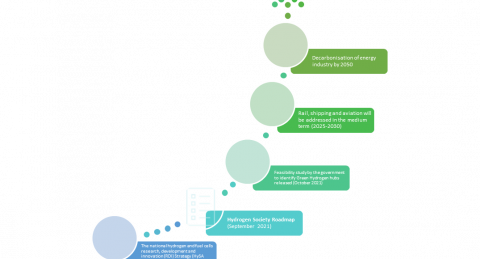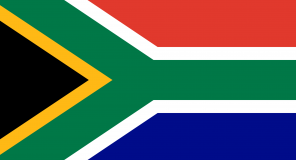South Africa
Green hydrogen vision
South Africa identifies green hydrogen as an essential component of its energy transition plan and towards the global commitment to decarbonize its economy (Hydrogen Society Roadmap, 2021).
South Africa has the competitive advantage to produce and export green hydrogen energy and aims to work on the existing opportunities to directly replace the hydrogen produced from natural gas by green hydrogen. The implementation of the hydrogen roadmap is in lines to tackle electricity supply issues and support inclusive growth and assist government to reduce unemployment, poverty, and inequality.
“If South Africa fully implements the Hydrogen Society Roadmap, within a few years, at least 20 000 new jobs will be created in South Africa as part of the adoption of the Hydrogen economy” - Blade Nzimande, Minister of Higher Education, Science and Innovation
National Strategy
The Department of Science and Innovation has launched a Hydrogen Society Roadmap for a hydrogen-based economy future. The roadmap targets four outcomes:
-
Create an export market for South African Green hydrogen and ammonia
-
Green the power generation sector
-
Decarbonize the transport and heavy industry sector
-
Locally manufacture green hydrogen supply chain components
The Department of Science and Innovation and partners launched a Hydrogen Valley Feasibility Study Report in October 2021. Three Green hydrogen hubs were identified- Johannesburg hub, Durban hub, and Mogalakwena and Limpopo.

Capacity and capacity targets
• According to the Hydrogen Society Roadmap (HSRM), the aim is to produce 500,000 tonnes per annum of green hydrogen by 2030.
• The South African government aims to deploy 10 GW of electrolysis capacity in the Northern Cape region by 2030 and 15 GW by 2040.
According to a report by National Business Initiative, South Africa could produce green hydrogen for $1.60 per kg by 2030, one of the lowest costs worldwide.
Impact targets
The Hydrogen Roadmap targets at the following impact of its measures:
-
100 H2 buses and trucks by 2025
-
500 H2 buses and trucks by 2030
-
30,000 jobs created annually by 2040
Policy Spotlight
CoalO2-X RDI Programme: The government aims to use renewable or green hydrogen and pollutants (CO2, SOx, NOx etc.) contained in the flue gas from coal fired boilers to make value added products that can support the transition to a decarbonized energy system.
Sustainable Aviation Project1: South Africa’s biggest ammonia supplier, Sasol Ltd, and Linde PLC bid for a project contract by the government (also under the Hydrogen roadmap) to produce sustainable aviation fuel (SAF) under the auspices of the German Federal Government’s H2Global auction platform.
Additionally, in November 2022, the Green Hydrogen Commercialisation Panel established by the Minister of Trade, Industry and Competition released its proposed South African Green Hydrogen Commercialisation Strategy (GHCS). Building on the Hydrogen Society Roadmap, the GHCS guides a path and actions towards the commercialisation of hydrogen technologies with targets for cost, production and deployment. It identifies six elements which need to be executed for the strategy to be successful: the prioritisation of exports, stimulation of the domestic market, localisation support, the securing of financing, proactive socio-economic development, and the role of the government in policy and regulatory support.
Furthermore, in December 2024, the South African government introduced a tax incentive providing a 150% tax deduction on investments in electric and hydrogen-powered vehicle production. This is due to enter into force in 2026.

Projects Spotlight
- Proof-of-Concept (POC) project: Sakhumnotho Power has partnered with Keren Energy Investments to produce green hydrogen at a site supplied by Namaqua Engineering in Vredendal, Western Cape. This project is the first in South Africa to demonstrate the feasibility of producing green hydrogen using solar energy as the energy source. The generated H2 will be used in hydrogen fuel cell vehicles.
- Hydrogen Valley1: An industrial cluster, bringing various hydrogen applications in the country together to form an integrated hydrogen ecosystem. The South African government is working with the Anglo-American Platinum and ENGIE on this programme. The valley starts near start near Mokopane in Limpopo, through the industrial and commercial corridor to Johannesburg and leading finally to Durban.
- Prieska Power Reserve Project: The Prieska Power Reserve Project is located in the Northern Cape Province of South Africa. Prieska Power Reserve Ltd is a collaboration between founders Mahlako a Phala Investments, the Central Energy Corporation (CENEC) and the Industrial Development Corporation (IDC). The project will start producing green hydrogen and ammonia in 2026. In the first phase, it is expected to produce 72,000 tonnes of green ammonia per year, with a green hydrogen content of 12,900 tonnes through 180 MW solar, 130 MW of onshore wind generation and 129.4 MWh of battery storage. By 2030, the project is expected to expand to over 500,000 tonnes of green ammonia.
- Coega Green Ammonia Project: This $5.7bn green ammonia plant, established by Hive Hydrogen and Linde, is located at the Coega Special Economic Zone alongside the Port of Ngqura in the Nelson Mandela Bay. It will produce up to 1.2 million tons per year of green ammonia and will be powered by 3.5 GW of renewable energy (a combination of offsite solar PV and wind projects), with an electrolyser capacity of 1,200 MW. The plant is expected to be commissioned in 2028, to create over 20,000 direct and indirect jobs, and to improve water supply by up to 25%.
- Renewstable Mpumalanga: Hydrogène de France is planning to install 1,500 MW of solar PV combined with 3,500 MWh of hydrogen storage on 1782 hectares of land. The six projects launched under the banner of Renewstable Mpumalanga (RMPU) are expected to inject 1.9 terawatt hours of stable electricity int the grid 24/7 - providing power to the equivalent of 1.4 million inhabitants within the country) - and will be able to peak at about 500 MW. This represents an investment of approximately $3bn. The RMPU projects are expected to come online from the end of 2026.
- HySHiFT sustainable aviation fuel project: The HySHiFT project, located in Secunda in Mpumalanga, aims to produce sustainable aviation fuel (SAF), or e-kerosene. The HySHiFT Consortium comprises Linde, Sasol, ENERTRAG and HydRegen Energy. The consortium plans to build a 200 MW electrolyser, 450 MW of renewable electricity, and to use the green hydrogen in Sasol’s existing Fisher Tropsch facilities to produce 50,000 tons per year of e-kerosene. The German Economic Affairs and Climate Action Ministry is providing €15 million in funding for the first phase of the project, during which a 40 MW electrolyser will be built.
- Sasolburg Green Hydrogen Pilot: The Sasolburg project, established by Sasol, has started operations in August 2023. Once fully operational, this pilot project will produce up to 5 tonnes a day of green hydrogen, and potentially green ammonia. The first green hydrogen was produced using electricity from a 3 MW solar PV facility built in Sasolburg.
Financing
-
The Department of Science and Innovation has provided €3 million to kick-start the CoalO2-X RDI Programme
-
German development bank KfW initiated a EUR 200 million programme to support the establishment of green hydrogen projects in South Africa.
-
In June 2023, the governments of the Netherlands, Denmark and South Africa launched the SA-H2 Fund that aims to raise $1bn in funding to facilitate and accelerate the development of a green hydrogen sector in South Africa.
-
In September 2024, the European Union announced two grants totalling approximately $35 million to enhance South Africa's green hydrogen initiatives. Green hydrogen projects utilize renewable energy to separate water into hydrogen and oxygen, producing fuel applicable across various sectors, including transportation, petrochemicals, and steel. The first grant from the EU, amounting to 140 million rand ($7.8 million), aims to assist the struggling South African state-owned company Transnet with infrastructure expenses, thereby supporting railways, ports, pipelines, and other logistic needs. The second grant, worth 25 million euros ($27.6 million), will aid South Africa, the continent's most industrialized economy, develop its green hydrogen value chain. Green hydrogen is essential for decarbonization efforts in South Africa and Europe. European nations are investing in green hydrogen projects across Africa to ensure a reliable fuel supply.
-
In March 2025, the EU announced that it would financially support green hydrogen projects in South Africa as part of a €4.7bn Global Gateway Investment Package. Most of this funding (€4.4bn) will go towards “supporting a clean and just energy transition in the country”, including the production and export to Europe of green hydrogen and platinum group metals used in PEM electrolysers. This investment package consists of EU grants (€303m), leveraging loans from the European financial institutions (€4.4bn) and South Africa’s development banks to support strategic value chain.
Government green hydrogen lead
-
Department of Science and Innovation, Hydrogen South Africa (HySA)
-
South African Cabinet
-
Minister of Trade, Industry and Competition
- Industrial Development Corporation of South Africa (IDC)
